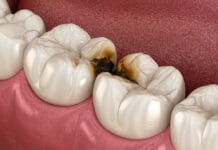In the United States, the use of marijuana has almost doubled since 2013, going from 7% to 13% of adult Americans using marijuana regularly, either recreationally or medically.1 Although the use of the drug is still federally banned, many states have limited legal restrictions to the drug, allowing people to gain easier access to various forms of marijuana for either medical or recreational use. Even with increasing popularity of marijuana used for medical purposes, as well as the legalization of use in certain states, there remain health concerns about the implications of regular marijuana use. Understanding the physiological and psychological effects, in addition to the dental implications, of regular cannabis use can help create a more complete picture for dental professionals when faced with patients who use marijuana on a regular basis.
Generally, cannabis can be used three different ways. The most common and well-known use of marijuana is by inhalation, or smoking. Cannabis can also be dried into a plant resin and baked into foods and taken in when eaten. Thirdly, it can be applied topically by using creams and oils that contain THC (delta-9 tetrahydrocannabinol), which is the main active ingredient in cannabis.2
Physiological and Psychological Effects of Marijuana Use
When cannabis is used for medical reasons, it is often used for its analgesic and antiemetic effects on patients. Physiological effects can include immediate tachycardia (increased heart rate), blood vessel dilation, as well as microcirculation disruptions. There have been limited studies suggesting a person’s risk for heart attack increases 5x during the first hour of marijuana use.3 This is most likely due to an increase in blood pressure, and a decrease in the body’s ability to carry oxygen. This could be important if you suspect a patient is under the influence of marijuana prior to dental treatment, especially if epinephrine is going to be administered. The research on the cardiovascular effects of marijuana use is relatively new and limited but should be kept in mind with patients who may have other risk factors for cardiovascular disease, such as age and overall physical health.
Psychologically, cannabis acts as a mild sedative and mood enhancer. After use, psychomotor and cognitive functions are impaired, and users report feeling relaxed, mellow, or sleepy. On the other hand, negative psychological effects have been reported; such as anxiety, paranoia, and hallucinations.4 Like any substance, many factors can affect side effects, such as weight, height, if other substances like alcohol or other drugs are being used, and the user’s tolerance to cannabis. Understanding the effects cannabis has physically, as well as neurologically, can be used to educate patients who may not understand changes which occur when the drug is used.
Oral Effect of Marijuana Use
As dental professionals, we understand many substances can have effects on the oral cavity. Knowing what to look for in patients who use cannabis on a regular basis, can help us educate and provide them with the safest and best treatment that best benefits their health. Most often, the first oral side effect that comes to mind with marijuana use is xerostomia. Although most people attribute the dry mouth effect to the smoking factor, rather than the actual cannabis, there is limited research that suggests using marijuana in any form has anticholinergic effects, not just smoking it.5 This would mean even patients who ingest edibles, instead of smoking marijuana, are at risk for xerostomia. Xerostomia can dry out the tissues of the mouth and lead to an increased risk of caries. Research confirms regular cannabis users are reported to have significantly higher numbers of caries than people who do not use cannabis, even on easy-to-reach, smooth surfaces.6
Another topic to discuss with patients is how regular cannabis use could increase their risk for periodontal disease. Research shows that regular cannabis users (at least once a month) experience attachment loss greater than 4mm on an average of 29.2 sites in the mouth, while those who use cannabis less frequently report an average of 19.2 sites greater than 4mm. This is important, as many people who use cannabis are unaware it could potentially damage the periodontium. Additionally, patients who may have other risks factors for periodontal disease, such as diabetes or inadequate homecare, should be educated frequent cannabis use could potentially increase their risk for periodontal disease.
Outside of caries and periodontal disease risk, it is important to understand how marijuana affects the risk of head and neck cancers. Cannabis does contain carcinogens, like tobacco, and long-term smoking of marijuana is associated with similar pathologies as tobacco use. However, at this time, it is unclear if this is because people who smoke marijuana may also smoke tobacco, which makes it hard to relate these problems only to smoking marijuana. Additionally, chronic inflammation of mucosa and gingival enlargement are associated with smoking marijuana, but it is unclear if it this is caused by the orally inhaled smoke or the cannabis itself.
Other oral abnormalities, such as erythroplakia, keratosis, and leukoplakia, or “cannabis stomatitis,” can potentially develop into malignant neoplasias, and should be continually monitored by dentists and hygienists.7 Dental professionals should be aware aggressive head and neck cancers, which are linked to regular cannabis use, tend to be elevated in younger users, under the age of 50 years old.8 This is important to remember when conducting intraoral exams and extraoral exams on this demographic, particularly if there is a history of regular smoking marijuana or tobacco. There are immunosuppressive properties associated with cannabis, particularly related to the human papillomavirus. HPV is highly associated with oral cancer, so this could potentially contribute to the increased cancer risk. On the other hand, studies have also shown no association between direct use of cannabis and head and neck cancers, so more research is needed to link the two accurately.9
The Benefit of Topical Fluoride and Nutritional Counseling
Patients who use cannabis regularly could benefit from topical fluoride to decrease the risk of caries. Nutritional counseling, including healthy snacking suggestions that do not include highly cariogenic snacks, will benefit this patient population. Along with a with individualized homecare instructions and education on the importance of biofilm removal, these implementations can educate and help treat patients using cannabis, thus contributing to their overall health, orally and throughout the rest of the body.
Knowing what to look for in patients who regularly use cannabis can aid hygienists in knowing how to treat patients who are open about their marijuana use. Most importantly, it is important patients feel comfortable sharing their medical histories, including drugs or substances, recreational or medical. Staying up to date with current state laws, asking questions in a nonjudgmental way, and having patients fill out regular, detailed medical histories can help open the door of communication between hygienists and patients in regards to cannabis use.
Before you leave, check out the Today’s RDH self-study CE courses. All courses are peer-reviewed and non-sponsored to focus solely on pure education. Click here now.
Listen to the Today’s RDH Dental Hygiene Podcast Below:
References
- McCarthy J. One in Eight US Adults Say They Smoke Marijuana. Gallup Social Series: Gallup; 2016.
- Brands, B. Sproule, B. & Marshman, J. (Eds.). (1998). Drugs & drug abuse (3rd ed.). Ontario: Addiction Research Foundation.
- Mittleman MA, Lewis RA, Maclure M, Sherwood JB, Muller JE. Triggering Myocardial Infarction by Marijuana. Circulation. 2001;103(23):2805-2809. doi:10.1161/01.CIR.103.23.2805.
- Campbell, A. (2000). The Australian illicit drug guide. Melbourne: Black Inc.
- Mangot AG. Bad trip due to anticholinergic effect of cannabis. General Hospital Psychiatry. 2013;35(6). doi:10.1016/j.genhosppsych.2013.06.010.
- Schulz-Katterbach M, Imfeld T, Imfeld C. Cannabis and caries–does regular cannabis use increase the risk of caries in cigarette smokers? Schweizer Monatsschrift fur Zahnmedizin = Revue mensuelle suisse d’odonto-stomatologie = Rivista mensile svizzera di odontologia e stomatologia 2009;119(6):576-83.
- Rechthand MM, Bashirelahi N. What every dentist needs to know about cannabis. Gen Dent 2016;64(1):40-3.
- Versteeg PA, Slot DE, van der Velden U, van der Weijden GA. Effect of cannabis usage on the oral environment: a review. Int J Dent Hyg 2008;6(4):315-20.
- Osazuwa-Peters N, Adjei-Boakye E, Loux TM, Varvares MA, Schootman M. Insufficient Evidence to Support or Refute the Association between Head and Neck Cancer and Marijuana Use. J Evid Based Dent Pract 2016;16(2):127-9.












